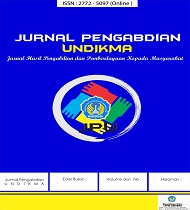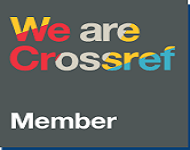Culturally Responsive Learning : Linguistic Landscape Study of MINHA Tebuireng Jombang, Indonesia
DOI:
https://doi.org/10.33394/jk.v10i2.10976Keywords:
Cultural Responsiveness, Linguistic Landscape, Diversity.Abstract
This study aims to explore the learning of various values through the MINHA Islamic linguistic landscape, the learning of exemplary values of figures through the linguistic landscape of MINHA figures, and the learning of multicultural communication from information boards and sign names. The research employed Linguistic Landscape Research with a qualitative approach. The linguistic data used in this study were obtained from images containing written text and videos providing information about Islamic history, figures, and guidelines. The data collection methods included observation and interviews. The findings revealed that three groups of linguistic features could serve as educational tools in MINHA, including linguistic features related to Islam, characters, and instructions for using MINHA and its facilities. The diverse values embedded in these linguistic features can enhance the effectiveness of learning by catering to students with varied backgrounds. The use of language in public spaces, such as in MINHA, constitutes a form of Linguistic Landscape, which may manifest as stickers on buildings in formal or informal settings. Linguistic Landscape (LL) serves as a tool to promote multilingualism and highlight the benefits of language.
References
Amaral, G., Bushee, J., Cordani, U. G., KAWASHITA, K., Reynolds, J. H., ALMEIDA, F. F. M. D. E., de Almeida, F. F. M., Hasui, Y., de Brito Neves, B. B., Fuck, R. A., Oldenzaal, Z., Guida, A., Tchalenko, J. S., Peacock, D. C. P., Sanderson, D. J., Rotevatn, A., Nixon, C. W., Rotevatn, A., Sanderson, D. J., … Junho, M. do C. B. (2013). No 主観的å¥åº·æ„Ÿã‚’ä¸å¿ƒã¨ã—ãŸåœ¨å®…高齢者ã«ãŠã‘ã‚‹å¥åº·é–¢é€£æŒ‡æ¨™ã«é–¢ã™ã‚‹å…±åˆ†æ•£æ§‹é€ 分æžTitle. Journal of Petrology, 369(1), 1689–1699. https://doi.org/10.1017/CBO9781107415324.004
Ardhian, D., Zakiyah, M., & Fauzi, N. B. (2023). Pesan dan simbol identitas dibalik kematian: Lanskap linguistik pada area publik tempat pemakaman umum di kota Malang. Litera, 22(1), 90–106. https://doi.org/10.21831/ltr.v22i1.54366
Asyari, H. (n.d.). TERJEMAH KITAB Adabul Alim wa Al-Muta’allim.
Aziz, A., & Gantara, P. (2021). Penggunaan Media Wordwall Dwi Bahasa Untuk Meningkatkan Kemampuan Bahasa Inggris Peserta Didik di SMPN Satap 3 Hanau Desa Paring Raya. Jurnal Studi Guru Dan Pembelajaran, 4(3), 627–634. https://doi.org/10.30605/jsgp.1.1.2018.99
Azmi, F., & Ardianti, S. (2023). Kisah Keteladanan KH. Hasyim Asy’ari. LECTURES: Journal of Islamic and Education Studies, 2(2), 111–117. https://doi.org/10.58355/lectures.v2i2.32ca
Baso, A., Sunyoto, K. N. H. A., & Mumamaziq, R. (2017). K.H. Hasyim Asy’ari, pengabdian seorang kyai untuk negeri.
Bhakti, W. P. (2020). Pergeseran Penggunaan Bahasa Jawa ke Bahasa Indonesia dalam Komunikasi Keluarga di Sleman. Jurnal Skripta, 6(2), 28–40. https://doi.org/https://doi.org/10.31316/skripta.v6i2.811
Bigdeli Rad, V., & Bin Ngah, I. (2020). The Role of Public Spaces in Promoting Social Interactions. Current Engineering and Technology, 3(1), 184–188.
Chozin, R., & Untoro. (2019). Pendidikan Agama Islam dan Budi Pekerti (1st ed.). Direktorat Jenderal Pendidikan Islam Kementrian Agama RI.
faiziEfendi, E., Sofyan, A., Sariono, A., Sastra Indonesia, J., Sastra, F., Jember, U., Kalimantan, J., Bumi, K., Boto, T., & 68121, J. (2015). Analisis Komponen Makna Kata yang Bermakna Dasar Memukul dalam Bahasa Madura Dialek Pamekasan. Publika Budaya, 1(1), 1–14.
Faizi, A. (2002). Pembelajaran Berbasis Kearifan Lokal: Kajian Etno Kritis. Cakrawala, 08, no. 02, 168–180.
Faizi, A. (2017a). Bahasa Madura sudah Saatnya Masuk Sekolah. Koran Pantura: Ruang Kita, 2 Januari 2017.
Faizi, A. (2017b). Morfologi Bahasa Madura. Madza Media.
Faizi, A., Saryono, D., Hasanah, M., Faizi, A., Saryono, D., & Hasanah, M. (2021). Culturally Responsive Madurese Language Learning. 13, 1314–1321. https://doi.org/10.9756/INT-JECSE/V13I2.211179
Gay, G. (2002). Culturally responsive teaching in special education for ethnically diverse students: Setting the stage. International Journal of Qualitative Studies in Education, 15(6), 613–629. https://doi.org/10.1080/0951839022000014349
Gay, G. (2010). A personal case of culturally responsive teaching praxis. In Culturally responsive teaching: Theory, research, and practice. (pp. 215–235).
Gay, G. (2015a). Connections Between Classroom Management and Culturally Responsive Teaching. Handbook of Classroom Management, 11237. https://doi.org/10.4324/9780203874783.ch13
Gay, G. (2015b). Culturally Responsive Teaching Principles, Practices, and Effects. Handbook of Urban Education, 10872. https://doi.org/10.4324/9780203094280.ch19
Gorter, D. (2006a). Further Possibilities for Linguistic Landscape Research Globalisation and the Spread of English. Linguistic Landscape, 81–89.
Gorter, D. (2006b). Linguistic landscape: A new approach to multilingualism. In Linguistic Landscape: A New Approach to Multilingualism.
Hermanto, H., & Masfufah, U. (2023). Bentuk dan Makna Ornamen Lawang Kembar Masjid Menara Kudus. Jurnal Ilmiah Arsitektur, 13(1), 117–125. https://doi.org/https://doi.org/https://doi.org/10.32699/jiars.v13i1.5127
Hernandez, C., & Shroyer, M. G. (2017). The use of culturally responsive teaching strategies among Latina/o student teaching interns during science and mathematics instruction of CLD students. Journal of Science Teacher Education, 28(4), 367–387. https://doi.org/10.1080/1046560X.2017.1343605
Iswanto, J. (2021). Pertumbuhan Institusi Sosial Politik Samudera Pasai, Malaka, Banten dan Mataram. Jurnal Bilqolam Pendidikan Islam, 2(1), 37–49. https://doi.org/https://doi.org/10.51672/jbpi.v2i1.46
Iwai, Y. (2019). Culturally Responsive Teaching in a Global Era: Using the Genres of Multicultural Literature. Educational Forum, 83(1), 13–27. https://doi.org/10.1080/00131725.2018.1508529
Jupri, J., Aprianoto, A., & Firman, E. (2022). The Application Of Linguistic Landscape In Mataram City Kota Madya Mataram, West Nusa Tenggara Province, Indonesia. Jurnal Ilmiah Mandala Education, 8(3), 2457–2464. https://doi.org/10.58258/jime.v8i3.3761
Jupriono, D., Amilia, D. L., & Paramita, F. B. A. C. (2022). Bentuk Kalimat, Posisi Proposisi, Pronomina, dan Nominalisasi dalam Ragam Bahasa Politik. TANDA: Jurnal Kajian Budaya, Bahasa Dan Sastra, 02(01), 42–54. https://aksiologi.org/index.php/tanda/article/view/317
Kadomi, M. F. (2022). Kyai dan Politik: Peranan K.H. Mahfudz Ridwan dalam Partai Kebangkitan Bangsa 1998-2008. Journal of Islamic History, 2(1), 1–24. https://doi.org/10.53088/jih.v2i1.117
Kevinia, C., Syahara, P., Aulia, S., & Astari, T. (2022). Analisis Teori Semiotika Roland Barthes Dalam Film Miracle in Cell No.7 Versi Indonesia. Journal of Communication Studies and Society.
Lynch, C., & Rata, E. (2018). Culturally responsive pedagogy: A New Zealand case study. International Studies in Sociology of Education, 27(4), 391–408. https://doi.org/10.1080/09620214.2018.1468274
Mark, S. L., & Id-Deen, L. (2020). Examining Pre-service Mathematics and Science Teachers’ Plans to Implement Culturally Relevant Pedagogy. Educational Action Research, 00(00), 1–19. https://doi.org/10.1080/09650792.2020.1775670
Marwah, S. S., Syafe’i, M., & Sumarna, E. (2018). Relevansi Konsep Pendidikan Menurut Ki Hadjar Dewantara Dengan Pendidikan Islam. TARBAWY : Indonesian Journal of Islamic Education, 5(1), 14. https://doi.org/10.17509/t.v5i1.13336
Muriungi, S. W., & Mudogo, and B. A. (2021). LINGUISTIC LANDSCAPE IN A MULTILINGUAL CONTEXT: A CASE OF KENYAN UNIVERSITIES. LLT Journal: A Journal on Language and Language Teaching, 24(2), 450–460. https://doi.org/10.24071/llt.v24i2.3673
Musa, M. M., Rahman, M. R., & Fauzi, R. (2023). Reflection of Gus Dur Thoughts and Movements in The View of Cirebon Figures. Al-Qalam: Jurnal Kajian Keislaman, 40(2), 130–144. https://doi.org/https://doi.org/10.32678/alqalam.v40i2.7064
Mustikasari, R., & Astuti, C. W. (2020). Pergeseran Penggunaan Bahasa Jawa pada Siswa TK dan KB di Kelurahan Beduri Ponorogo. Alinea: Jurnal Bahasa Sastra Dan Pengajarannya, 9(1), 64–75. http://jurnal.unsur.ac.id/ajbsi
Prayudi, S., & Nasution, W. (2020). Ragam Bahasa dalam Media Sosial Twitter: Kajian Sosiolinguistik. Jurnal Metamorfosa, 8(2), 269–280. https://doi.org/https://doi.org/10.46244/metamorfosa.v8i2.1140
Roofe, C. (2018). Why can’t everyone pass? Context responsive teaching and learning in urban primary schools. Pedagogy, Culture and Society, 26(3), 449–466. https://doi.org/10.1080/14681366.2017.1417893
Rosyid, M. (2021). Situs Hindu Pra-islam di Kudus dan Sikap Toleran Sunan Kudus. Khazanah Theologia, 3(3), 171–180. https://doi.org/10.15575/kt.v3i3.10975
Samuels, A. (2018). Exploring Culturally Responsive Pedagogy: Teachers’ Perspectives on Fostering Equitable and Inclusive Classrooms. SRATE Journal, 27(1), 22–30.
Shohib, M. (2020). Substansi Pendidikan Multikultural Perspektif Gus Dur. Jurnal Pendidikan Agama Islam, 04(1), 75–87.
Sholikah, & Mumtahanah, N. (2021). Kontribusi Kebangsaan Kiai Hasyim Asy’ari: Membangun Relasi Harmonis Islam dan Indonesia. Akademika, 15(1), 36–50. https://doi.org/10.24042/ajsk.vl9il.3397
Sitorus, M. Y., Andriyani, R., Sari, S., & Fadillah, Y. S. (2020). Pemanfaatan Media Audio Visual Dalam Pembelajaran Baca Tulis Alquran Di Madrasah Ibtidaiyah. Jurnal Maslahah Pengabdian Masyarakat, 1(2), 96–104.
Stowe, R. (2017). Culturally Responsive Teaching in an Oglala Lakota Classroom. The Social Studies, 108(6), 242–248. https://doi.org/10.1080/00377996.2017.1360241
Sultani, Z. I. M., Anastasia, M. S., Paramanandana, S., Salamah, K., & Towaf, S. M. (2021). Pesantren sebagai Pusat Pembelajaran dan Pendidikan Agama Islam dalam Mengembangkan Tasawufisasi di Banten (1552-1682). Candrasangkala: Jurnal Pendidikan Dan Sejarah, 7(1), 35–50. https://doi.org/http://dx.doi.org/10.30870/candrasangkala.v7i1.6458
Susanto, E. (2012). Revitalisasi Nilai Luhur Tradisi Lokal Madura. KARSA: Journal of Social and Islamic Culture, 12(2), 96–103. https://doi.org/10.19105/karsa.v12i2.135
Taylor, S. V. dan D. M. S. (2011). Culturally Responsive Pedagogy: Teaching Like Our Students’ Lives Matter (Firstediti). Emerald Group Publishing Limited.
Villegas, A. M. (1991). Culturally Responsive Pedagogy for the 1990s and Beyond. Trends and Issues Paper No. 6. (Issue Trends and Issues Paper).
Villegas, A. M., & Lucas, T. (2002). Preparing culturally responsive teachers rethinking the curriculum. Journal of Teacher Education, 53(1), 20–32. https://doi.org/10.1177/0022487102053001003
Wahyono, S. B. (2006). Studi Etnografi untuk Pendidikan Perkotaan dan Pedesaan. Jurnal Dinamika Pendidikan, 2(1), 1–15.
Wirajayadi, L., Yunus, M., Suryanirmala, N., Winata, A., & Haeri, Z. (2021). Cerminan Budaya dalam Bahasa Daerah: Sebagai Penanda Identitas Diri Masyarakat Sasak. Journal of Innovation Research and Knowledge, 1(3), 367–372. https://doi.org/https://doi.org/10.53625/jirk.v1i3.206
Yamin, M., Firmansah, Subhan, & Fadlin. (2022). Bumi Rempah Nusantara untuk Dunia: Rekonstruksi dan Revitalisasi Jalur Rempah. PIOR: Jurnal Pendidikan Olahraga, 1(1), 32–39. https://jurnal.habi.ac.id/index.php/Pior
Zamani, N., & Inayatul Ilahiyah, I. (2019). Implementasi Nilai-Nilai Multikultural Di Pesantren Tebuireng. Al-Misbah (Jurnal Islamic Studies), 7(1), 14–20. https://doi.org/10.26555/almisbah.v7i1.1128
Zainuri, A., & Al-Hakim, L. (2021). Pemikiran Gus Dur dalam Kehidupan Pluralitas Masyarakat Indonesia. Islamika inside: Jurnal Keislaman Dan Humaniora, 7(2), 167–197. https://doi.org/10.21093/lj.v14i1%20JUNI.208
Zhang, L. dan Y. J. W. (2016). Culturally responsive teaching in China: instructional strategy and teachers’ attitudes. Intercultural Education, 27(1), 54–69. https://doi.org/10.1080/14675986.2016.1144632
Downloads
Published
How to Cite
Issue
Section
Citation Check
License
License and Publishing Agreement
In submitting the manuscript to the journal, the authors certify that:
- They are authorized by their co-authors to enter into these arrangements.
- The work described has not been formally published before, except in the form of an abstract or as part of a published lecture, review, thesis, or overlay journal.
- That it is not under consideration for publication elsewhere,
- That its publication has been approved by all the author(s) and by the responsible authorities tacitly or explicitly of the institutes where the work has been carried out.
- They secure the right to reproduce any material that has already been published or copyrighted elsewhere.
- They agree to the following license and publishing agreement.
Copyright
Authors who publish with JK agree to the following terms:
- Authors retain copyright and grant the journal right of first publication with the work simultaneously licensed under a Creative Commons Attribution License (CC BY-SA 4.0) that allows others to share the work with an acknowledgment of the work's authorship and initial publication in this journal.
- Authors are able to enter into separate, additional contractual arrangements for the non-exclusive distribution of the journal's published version of the work (e.g., post it to an institutional repository or publish it in a book), with an acknowledgment of its initial publication in this journal.
- Authors are permitted and encouraged to post their work online (e.g., in institutional repositories or on their website) prior to and during the submission process, as it can lead to productive exchanges, as well as earlier and greater citation of published work.
Licensing for Data Publication
-
Open Data Commons Attribution License, http://www.opendatacommons.org/licenses/by/1.0/ (default)

This work is licensed under a Creative Commons Attribution-ShareAlike 4.0 International License.







